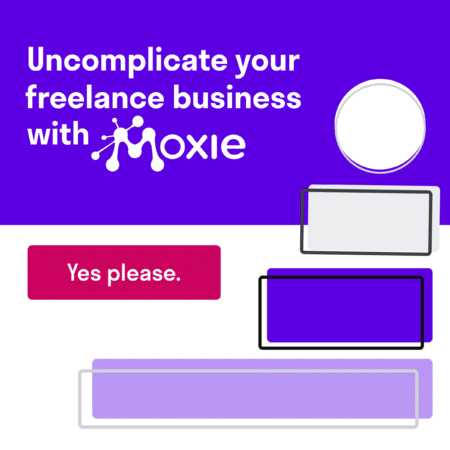My husband Eddie and I started our design agency back in 2006.
For the first several years, we priced our projects hourly. We estimated the number of hours based on past performance and only charged clients for how much time it actually took.
We felt it would “reward” easy-going clients and make it worth our while for those “pickier” clients who required more revisions.

The Problem
We realized we could only grow and make more money by raising our hourly rate or by working more hours.
Working more hours would just lead us to burnout and merely raising our rate didn’t seem like the right solution, either.
And oh, the price hagglers.
We definitely had those clients whose budget limited our hours. I’m sure you can relate to feeling like you couldn’t provide the client the best you have to offer because of their budget constraints.
The Solution
We wound up reading a booklet from Freshbooks called Breaking the Time Barrier that started us on our journey into value-based pricing.
Light bulbs starting shattering for us.
The booklet focused on pricing for the value the project brought to the client instead of the hours it took to complete it. Because after all, your clients are not paying you for hours, they are paying you to accomplish a specific goal.
Think about it this way: When you’re sick you don’t pay for your medicine based how long it took to make it. You buy it based on the results you hope to achieve. You want to get well and will pay almost anything (within reason) to feel better.
The same is true for design work.

Most clients (and the best ones at that) couldn’t care less how many hours it takes you to finish a project. They just want the results.
Success?
YES.
Since switching over to this pricing model, we’re attracting the kinds of clients we’d spent years searching for.
These clients are not usually concerned over price and are happy to pay for the value we provide them.
It’s created a more satisfying work experience for us and for our clients. We only wish we would’ve used this pricing structure earlier!
Common Questions
How do you figure the value?
I’ve heard some people say to figure your price based on 10% of the revenue the client expects to receive from the project. This gets the client thinking about the project more as an investment rather than an expense.
However, figuring out this percentage gets a little tricky because not all clients know how much they’re going to make from it or don’t always want to share that information.
We use a combination of factors instead.

Our pricing depends on:
- how many team members will be involved,
- what level of skills are being used,
- how valuable that project is to the client,
- how visible the client is,
- the going rate,
- etc.
Though it really boils down to the value:
What value do we bring to the client? What are we worth to the client?
Breaking the Time Barrier says:
For a lot of your clients, getting your solution sooner rather than later has more value, and for that they’d pay more, not less.
In the first years of our business we charged less because the value of what we were providing was less.
Over the years, however, we’ve grown tremendously in what we offer and realized our price point didn’t match up with our skill set anymore (our prices were too low for what we were offering).
And the better we got, the more quickly we were able to do things, which meant we were getting paid less because we were spending less hours.

It should have been the other way around!
Another example: Elf is one of my favorite movies. In it a writing team brings in “THE Miles Finch” to offer his elite writing skills. They’re willing to give him whatever he wants because they want the results he brings.
You may not be demanding an S500 with an interior temperature of 71 degrees as Miles did, but you can align yourself to get paid what you’re worth.
Can you share a pricing example?
Sure thing.
In our old pricing model, we would multiply hours plus hourly rate to find the total cost of a given website.
Our last hourly rate was around $85, so if we spent 50 hours on a website we charged $4250. Our websites were averaging around $2-5K with this pricing model.
After looking at national averages using a variety of tools (The Graphic Artists Guild Handbook: Pricing & Ethical Guidelines, online research, etc.), as well as our own knowledge of the industry, we were able to more accurately determine our pricing based on what we can offer.
We realized that, on average, we provide more value to our clients than other firms charging around the $2-5K range, including:
- Focusing more on website strategy,
- Completing projects more quickly,
- Treating our clients better,
- etc.
With our process, the clients get a better ROI because we put more care and effort into their project.
Now, our websites average around $10K, and this may increase as we add even more value.
Being at this price range brings in companies around 50-1,000 employees.
To figure your own rate, you’ll have to honestly evaluate your level of experience, plus the level of strategy (if any) being provided to the client and use online resources to see where you fall.
How do you transition to value-based pricing?
If you’re an established entrepreneur and you realize you’ve been undervaluing yourself, you’ll have to endure some growing pains at the new rate.
(We went through this stage, too.)
This means you have to turn away clients whose budgets are too small for what your new price range was. Initially it will be painful for you (as it was for me) to watch these potential clients go. It is so tempting to offer them your previous rate or to bargain with them.
As time goes on, though, it becomes easier and easier to stick to your guns and remain confident in what you’re offering.
And we realized that the lower-paying clients were usually the tougher clients to work with, while the higher-paying clients didn’t care as much about cost. They just wanted it done right and were willing to pay for the quality work and results.
My advice: push through the pain of losing potential clients…you will eventually land your ideal clients. You might have to go through a little dry spell to get there, but it will be worth it in the end.
How do you tell if a client is within your price range?
For the first several years, we put together quick price quotes for everyone that came our way.
A lot of the time we had no idea what their budget was and the surprise was on all of us at the quote reveal.
(This got old pretty quickly.)
So we switched to multiple page, in-depth proposals personalized to each client. It now takes us anywhere from 1-5 hours to put together a proposal.
For this reason, we qualify our potential clients before getting to the proposal stage.
Here’s how:
In my initial consultation with the client, I spend about an hour getting to know them, their company, their goals, their target markets, etc. At the very end of the conversation (very important to bring this up at the end, NOT the beginning) I ask them for their budget for the project.
If they are reluctant to tell me, I either:
- Follow up by email or call with a rough verbal estimate or
- Ask them to specify what price range they fall within.
I give them three price range choices with our average range being the first choice. This almost always gets them to tell me where they fall.
From here, I’ll proceed to the proposal stage or recommend another option for them if their budget is too low.
What do you do about old clients that are still on the hourly pricing model?
We have slowly been switching our clients over to the new pricing model.
Most of them like it better because they know up front how much it’s going to cost and there’s no surprise at the end of the project.
Final Thoughts
From Breaking the Time Barrier:
Selling hours actually creates a conflict of interest. It puts you and the client on opposite sides of the table.
If you’re selling hours, it’s in your best interest to take longer, to bill more hours. But your client is interested in getting solutions that work as promptly as possible. What if you work quicker for one client than another, but deliver the same value? Should you penalize the client you worked longer for?
If you’re slow, it’s not their fault.
And why is it that your typical career job pays a salary and not by the hour?
It’s because the company is not paying you to fill hours. They’re paying you for what you contribute through a culmination of your education, experience, skill set, etc.
So why should we creative entrepreneurs be any different?
Keep the conversation going...
Over 10,000 of us are having daily conversations over in our free Facebook group and we'd love to see you there. Join us!


Great article. What do you think about showing your base starting prices?
Hi Sean, thanks for the question. Are you referring to sharing your base starting prices on your website? We do not have a price list on our website, but on our contact form, there is a drop-down for budget that lets them get an idea of where we are price-wise. This helps to pre-qualify people before they submit the form because they have to choose a budget from that list. Hope that helps!
Thank you. Yes that also does the job. I did use the budget selector for a while and majority just pick the lowest price. So now I just give them 3 prices based on 3 different project scope and deliverables.
This was a great read Mindy. Thank-you! I’ve been transitioning over to more of a value-based pricing mode. It takes a bit of a leap of faith when you come to realize that perhaps you’ve been under-valuing yourself. Wisdom has taught me to “qualify potential clients before getting to the proposal stage” which has saved tons of time for sure!
It definitely does take a leap of faith 🙂 So nice to hear another positive comment about the article. All the best in your business!
Like a good boy would when he sees a good write-up, Lovely piece of information.
Thanks for sharing.
I love this article. Thank you for sharing the real examples and actually answering the questions we all have!
Laura, glad to hear it was helpful. I know when we first starting out in this model I had a bunch of questions, so hopefully I covered a lot of the main ones 🙂
Good advice! I work full-time for a company but also freelance. I work on an hourly rate and just increased my rate, but still go on my old rate for a couple of clients. I have been looking to switch over to this model and the benefits seem to be great! And yes, I’m ready to have “better clients”. Tired of dealign with the lower-paying tougher clients who seem to want the moon for a dime:-)
Glad to hear the article was encouraging 🙂
Nice I agree!! I do value based pricing as well…